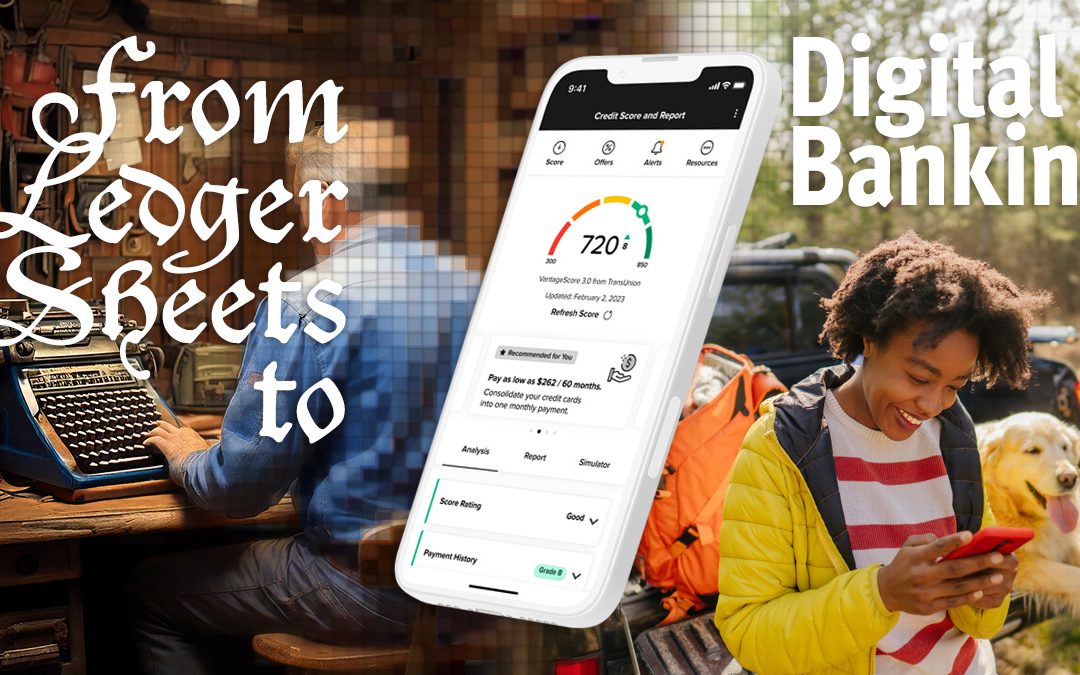The Bottom Line
Small business is important to Central Oregon, and to Mid Oregon. Find tips and resources for business, and information about Mid Oregon’s commercial services and business members.

From Ledger Sheets to Digital Banking: My Journey and 5 Tips for Financial Wellness
From Ledger Sheets to Digital Banking: My Journey and Five Smart Moves for Financial Wellness
When I was a child, I watched my father balance his checkbook once a month like clockwork. He’d retreat to the little room off the garage he called his “office,” armed with an ancient mechanical adding machine. I can still hear the rhythmic tap-tap-tap and the roll-chunk as the machine printed each calculation on a narrow strip of paper. It went on for hours, but at the end of the day, his account book balanced perfectly.
Those memories taught me something important: financial wellness takes discipline and attention. Back then, it was all about ledgers, calculators, and patience. Today, we have tools that make managing money easier and faster than ever—but the principles remain the same. As we head into a new year, I want to share five strategic moves that can help you take control of your finances and feel confident about your future.
1. Audit Your Accounts
Back in the day, auditing meant flipping through pages of handwritten entries and reconciling every penny. Today, it’s much simpler—but just as important.
Start by reviewing all your accounts:
- Checking and savings
- Retirement accounts
- Old accounts you might have forgotten about
Ask yourself:
- Does each account have a clear purpose?
- Are you contributing to retirement?
- Do you have an emergency fund?
Pro Tip: Consolidating accounts can reduce fees and give you a clearer picture of your finances. Mid Oregon’s Digital banking tool make this easy—you can see everything in one place, even accounts from other institutions.
2. Set Money Goals
When I was younger, goals were simple: save enough for a family vacation or a new appliance. We didn’t have apps or dashboards—just envelopes and handwritten notes.
Today, goal-setting is more structured and powerful. Start by listing what went well last year, then identify what you’d like to improve. Break big goals—like paying off debt or saving for a home—into smaller steps.
Tips for Success:
- Be specific and realistic
- Start small—two or three goals are plenty
- Stay flexible. Life happens!
Pro Tip: Use the savings goal tool under the Financial Wellness tab in the Mid Oregon Digital Banking to track your progress and stay accountable.
3. Optimize Investment Accounts
Investing used to feel intimidating without easy access to information. Now, you can review and adjust your accounts with just a few clicks.
Action Steps:
- Check your retirement contributions and make sure you’re taking advantage of employer matches
- If you have old 401(k) accounts, consider rolling them into an IRA for better control
- Explore IRA certificates for competitive rates and long-term growth
4. Enlist Professional Help
Years ago, financial advice often came from family or friends. Today, you have access to experts—and many services are free.
Our institution offers:
- Financial consultations visit any branch to review your goals and accounts
- Book a Retirement & Investment planning session with Mid Oregon Wealth Management to help you prepare for the future
- Attend one of the Financial Workshops offered by Mid Oregon to make everyday money management and future planning easier
Don’t hesitate to ask for help. Professional guidance can simplify complex decisions and give you peace of mind.
5. Plan for Tax Season
I remember when tax season meant paper forms spread across the kitchen table and hours of calculations. Now, you can prepare with far less stress.
Start early:
- Organize your documents now
- Use digital tools to track deductions and income throughout the year
- Seek professional help if needed—did you know that just being a member at Mid Oregon you can get discounts for your tax prep? Click here for more information.
Closing Thoughts
Financial wellness isn’t about perfection—it’s about progress. The tools have changed since my father’s days with his mechanical calculator, but the goal remains the same: clarity, confidence, and control.
If he could balance the books with nothing but paper and patience, imagine what you can do with today’s technology. Start now, take small steps, and make this the year you thrive.

Don’t Get Grinched! Top Holiday Scams You Need to Know.
Safely past Thanksgiving, they’re out there waiting. Right now, the scammers are looking to ruin this holiday season of gifting for their own benefit. Whether online or in person, these greedy grinches are after what they can grab using tried and tested methods. AI is also helping scammers appear more legitimate. Some of the top scams are listed below to help you have a scam-free holiday season.
Phony Shipping Notices
Whether you’re expecting a delivery or not, scammers will alert you via phone, email, or text there’s a package on the way or you missed a delivery. They’ll claim to be from FedEx, the post office, or other package delivery service sending you a link to track the fake delivery. The links lead to a spoofed website or they can download malware. Some ask for a credit card number or other PII for the bogus delivery.
TIPS: Don’t click on any links and go to the true delivery service or merchant website to see if there’s really a package delivery needing your help. Don’t provide your PII or payment information when asked, it’s a sign something isn’t quite right.
Missing Packages
Porch Pirates are out in full force looking for package deliveries left on doorsteps and other obvious places. They love driving around neighborhoods looking for unattended deliveries. It’s free stuff for these grinch-pirates but it’s a headache for you when you’re not at home. Getting stolen merchandise replaced or refunded can take time you don’t have for the gift-giving season.
TIPS: Instruct deliveries to a side or back door when possible or send to a friend or neighbor you know will be home. Home security cameras catch Porch Pirates in the act for law enforcement. Package tracking using the legitimate delivery service website can help with delivery days and times to be on the lookout. Use delivery options like Amazon’s Key or Hub Lockers or pick up the item from the merchant when possible.
Fake Order Notices
Emails arrive about a purchase you’ve made from a retailer or third-party payment like PayPal, to verify your order. The purchase amount is enough to make you panic, and you’ll want to resolve the matter quickly. The email includes a link or phone number to dispute the order, and scammers know you’ll likely follow it. The link can go to a spoofed website to steal your PII, or it will outright ask for your payment card and login information so the scammer can go a shopping spree.
TIPS: Don’t follow links or provide sensitive information. Instead, go directly to the merchant’s true website and make inquiries from there. Check your payment card for unauthorized charges. If there isn’t anything in either of those locations, it’s likely a scam.
Sob-sters & Fake Relatives
Appeals for donations including with GoFundMe can be bogus, so if you’re giving this holiday season, stick with well-known or local charities. Calls from a family member asking for a money wire to get out of jail, for instance, call a family member to confirm it’s legit. Emails with similar scenarios, especially asking for money via gift cards, is the sign of a true scam.
TIPS: Call and verify! Contact the recipient of the donation. For family—call another family member to verify the story before sending a dime.
Content provided by Stickley on Security.
For more tips on protecting your personal information, visit Mid Oregon’s Security and Fraud Page: https://ow.ly/hjHm50V9XE1

Is Your Phone Safe for the Gate?
Simple Tips to Stop Data Theft While Traveling
Before your next flight, take this crucial step to safeguard your finances. The Transportation Security Administration (TSA) has issued a warning about “juice jacking,” where hackers install malware on public USB charging ports in airports and other travel hubs.
What’s Happening
Plugging your phone or device directly into these ports can compromise your sensitive data, including banking information and passwords.
Here’s how to protect yourself
Bring Your Own Power: Always travel with a fully charged, TSA-compliant battery pack (power brick) so you don’t need to rely on public charging stations.
Use Charging-Only Cables: If you must use a public USB port, use a charging-only cable. These cables allow power to flow but block any data transfer, keeping your information safe.
Be Cautious with Wi-Fi: Avoid connecting to free public Wi-Fi networks, especially if you plan to make purchases or access sensitive accounts. Hackers often exploit unsecured networks to steal personal information.
Protect your journey and your savings by taking these simple precautions every time you travel. For more tips on protecting your personal information, visit Mid Oregon’s Security and Fraud Page: https://ow.ly/hjHm50V9XE1.
